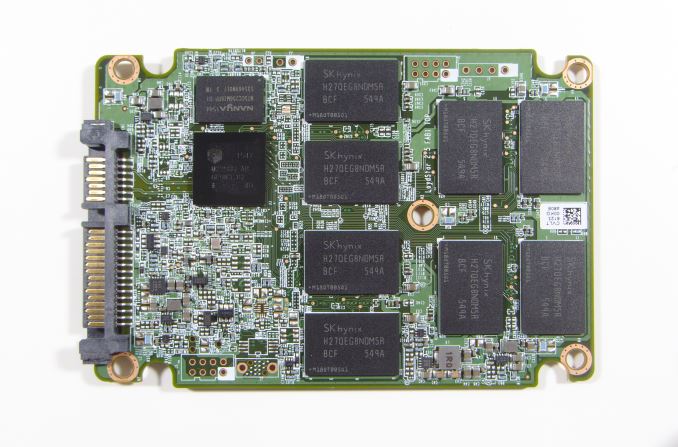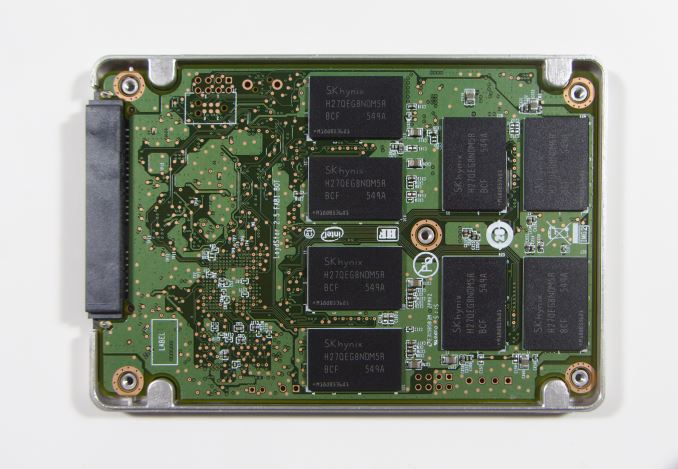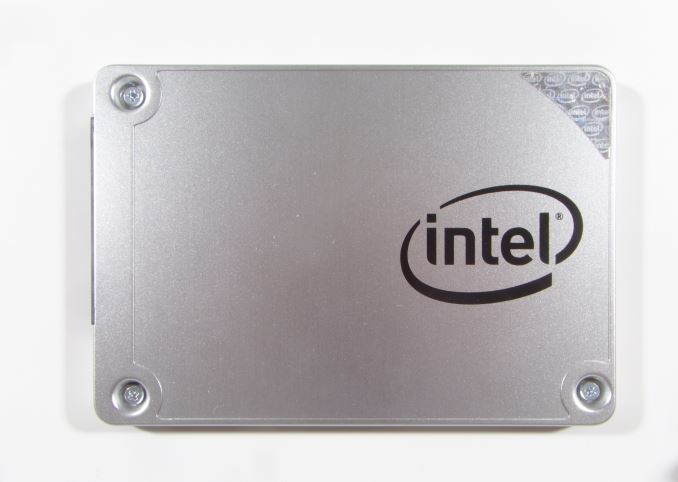
Original Link: https://www.anandtech.com/show/10432/the-intel-ssd-540s-480gb-review
The Intel SSD 540s (480GB) Review
by Billy Tallis on June 23, 2016 9:00 AM EST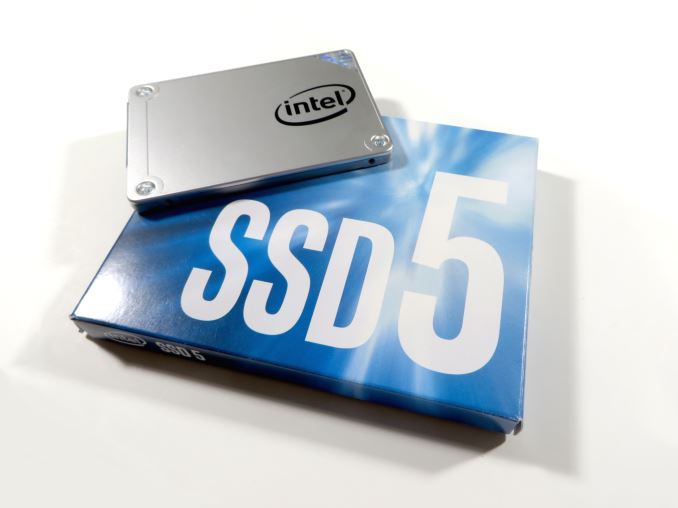
Every few years, Intel releases a new SSD controller that raises the bar for the whole industry. In between those shake-ups, the competition catches up and surpasses Intel. This pattern is especially pronounced in the consumer SSD market where Intel's mostly enterprise-focused chips cannot keep pace with the constant price cuts. During those interim years Intel turns to third-party controllers to fill the gaps in the product line that their own controllers cannot serve.
This year, Intel's decision to release an affordable mainstream SATA SSD has led them to use a Silicon Motion controller. But "affordable" by today's standards means using 15/16nm TLC NAND flash, and Intel doesn't make that either. They chose not to invest in the 16nm node at IMFT (their flash manufacturing partnership with Micron) so Intel has to buy their flash on the open market.
The result is the Intel 540s, using Silicon Motion's new SM2258 controller and SK Hynix 16nm TLC NAND. The SM2258 controller is the successor to the SM2256, Silicon Motion's first controller designed for use with TLC flash. SM2258 builds on that design by moving from 55nm fabrication to 40nm and incorporating several hardware tweaks including more flexible SLC caching and support for 3D NAND.
The Hynix TLC used in the Intel 540s is the same NAND that is inside the ADATA Premier SP550, one of two products we've tested that use the SM2256 controller. This gives us the opportunity to directly observe what's improved with Silicon Motion's controller and firmware since last year. The price history of the ADATA SP550 also shows that Intel should be able to make the 540s a very affordable product. It also appears that Intel has retired the use of 3xx model numbers to designate entry-level SSDs and all such models are now classified as legacy products.
| Intel SSD 540s Specifications | ||||||
| Capacity | 120GB | 180GB | 240GB | 360GB | 480GB | 1000GB |
| Controller | Silicon Motion SM2258 | |||||
| NAND Flash | SK Hynix 16nm TLC | |||||
| Sequential Read | 560MB/s | |||||
| Sequential Write | 400MB/s | 475MB/s | 480MB/s | |||
| Random Read IOPS | 60k | 71k | 74k | 78k | ||
| Random Write IOPS | 50k | 85k | ||||
| TCG Opal Encryption | No | |||||
| Power Management | Slumber and DevSleep | |||||
| Form Factor | 2.5" 7mm and M.2 2280 | |||||
| Warranty | 5 years | |||||
| Recommended Customer Price | $64 | $79 | $99 | $139 | $174 | $344 |
The 540s has Intel's typical aluminum casing housing a full-size PCB. Our 480GB sample had 16 packages each with two dies of the SK Hynix TLC. The new SM2258 controller uses the same 14mm x 14mm package as the SM2256, with a single external DRAM package next to it. As is typical for low-cost consumer drives, there are no power loss protection capacitors. There is a thermal pad between the controller and the case, something we saw for the SM2256 on the Crucial BX200 but not the ADATA SP550.
The PCB also bears the "Loyd Star" codename which the 540s shares with Intel's SSD E 5400s for the embedded market and the SSD DC S3100 for the enterprise market. The E 5400s covers only small capacities, ranging from 48GB to 180GB while the 540s is available in capacities from 120GB to 1000GB and the DC S3100 covers 180GB to 1000GB. All three product lines include some in-between sizes that are uncommon to find on modern drives. The 540s and E5400s are both available as 2.5" or M.2 drives while the DC S3100 is only available as a 2.5" drive.
For this review, the Intel 540s will primarily be compared against the two SM2256 products we've tested: the ADATA Premier SP550 and the Crucial BX200. The latter shipped with poorly-tuned firmware that made it a disappointment all around, but the former has been a relatively successful budget drive by offering acceptable performance at some of the best prices on the market. The Intel 540s is positioned slightly higher in the market due to carrying a 5-year warranty compared to three years for most budget TLC drives, but in terms of performance that's what it is competing against.
Other important drives to compare against will include the Toshiba OCZ Trion 150, a higher-performing drive using a controller based on the Phison S10 paired with Toshiba 15nm TLC, and the SanDisk X400 using Marvell's 88SS1074 controller and SanDisk's 15nm TLC. The SanDisk X400 seems to be the fastest planar TLC drive on the market, and it is available in both 2.5" and single-sided M.2 form factors. The SanDisk X400 also has a 5-year warranty.
| AnandTech 2015 SSD Test System | |
| CPU | Intel Core i7-4770K running at 3.5GHz (Turbo & EIST enabled, C-states disabled) |
| Motherboard | ASUS Z97 Pro (BIOS 2701) |
| Chipset | Intel Z97 |
| Memory | Corsair Vengeance DDR3-1866 2x8GB (9-10-9-27 2T) |
| Graphics | Intel HD Graphics 4600 |
| Desktop Resolution | 1920 x 1200 |
| OS | Windows 8.1 x64 |
- Thanks to Intel for the Core i7-4770K CPU
- Thanks to ASUS for the Z97 Deluxe motherboard
- Thanks to Corsair for the Vengeance 16GB DDR3-1866 DRAM kit, RM750 power supply, Carbide 200R case, and Hydro H60 CPU cooler
Performance Consistency
Our performance consistency test explores the extent to which a drive can reliably sustain performance during a long-duration random write test. Specifications for consumer drives typically list peak performance numbers only attainable in ideal conditions. The performance in a worst-case scenario can be drastically different as over the course of a long test drives can run out of spare area, have to start performing garbage collection, and sometimes even reach power or thermal limits.
In addition to an overall decline in performance, a long test can show patterns in how performance varies on shorter timescales. Some drives will exhibit very little variance in performance from second to second, while others will show massive drops in performance during each garbage collection cycle but otherwise maintain good performance, and others show constantly wide variance. If a drive periodically slows to hard drive levels of performance, it may feel slow to use even if its overall average performance is very high.
To maximally stress the drive's controller and force it to perform garbage collection and wear leveling, this test conducts 4kB random writes with a queue depth of 32. The drive is filled before the start of the test, and the test duration is one hour. Any spare area will be exhausted early in the test and by the end of the hour even the largest drives with the most overprovisioning will have reached a steady state. We use the last 400 seconds of the test to score the drive both on steady-state average writes per second and on its performance divided by the standard deviation.
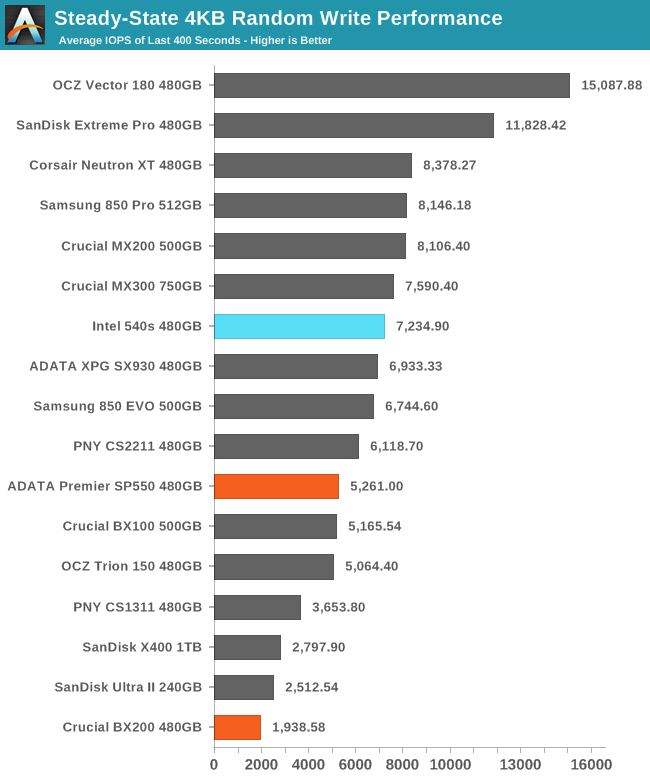
Right from the start we see a substantial improvement of the SM2258 over SM2256, as steady-state random write speed has increased by 37%. This puts the Intel 540s well ahead of any other planar TLC drive and ahead of a few low-end MLC drives as well.
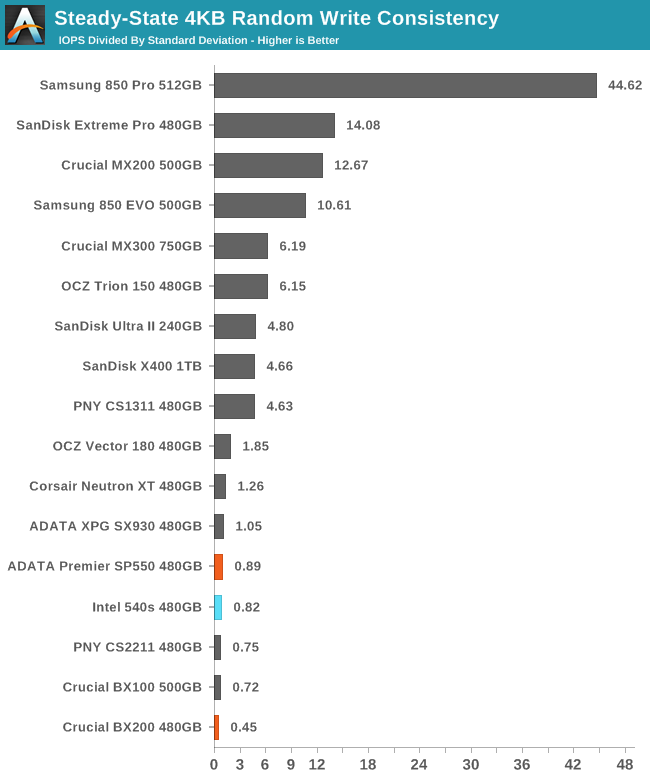
While the average random write speed has improved, the consistency is a bit worse and the Intel 540s scores in the bottom tier of drives. Phison's most recent generation of TLC drives managed to deliver very consistent steady state performance, but Silicon Motion still has a lot of room for improvement here.
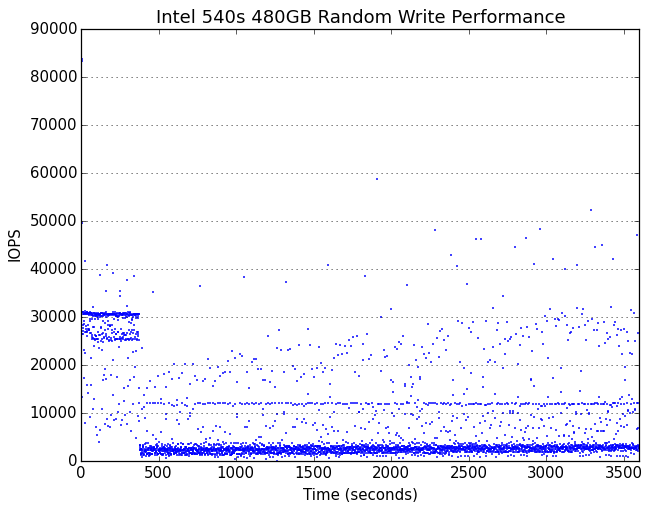 |
|||||||||
| Default | |||||||||
| 25% Over-Provisioning | |||||||||
The consistency of the 540s was clearly poor even before the transition to steady state, but during that early phase of the test it delivered twice the IOPS of the ADATA SP550.
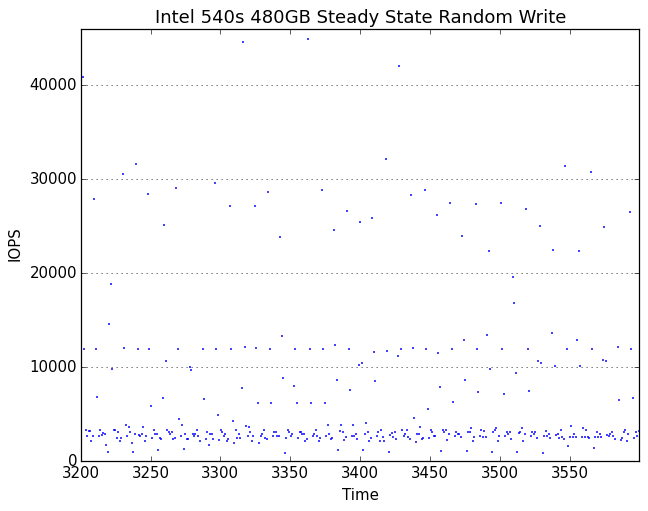 |
|||||||||
| Default | |||||||||
| 25% Over-Provisioning | |||||||||
Once in steady state, the 540s performance mostly stays slightly above the SP550. Both drives have frequent outliers beyond their band of usual performance, and the outliers are almost all in the direction of better performance. The Intel drive's outliers hit some much higher peaks than the ADATA SP550, suggesting that the new SM2258 controller may have significantly improved performance on bursty workloads.
AnandTech Storage Bench - The Destroyer
The Destroyer is an extremely long test replicating the access patterns of very IO-intensive desktop usage. A detailed breakdown can be found in this article. Like real-world usage and unlike our Iometer tests, the drives do get the occasional break that allows for some background garbage collection and flushing caches, but those idle times are limited to 25ms so that it doesn't take all week to run the test.
We quantify performance on this test by reporting the drive's average data throughput, a few data points about its latency, and the total energy used by the drive over the course of the test.
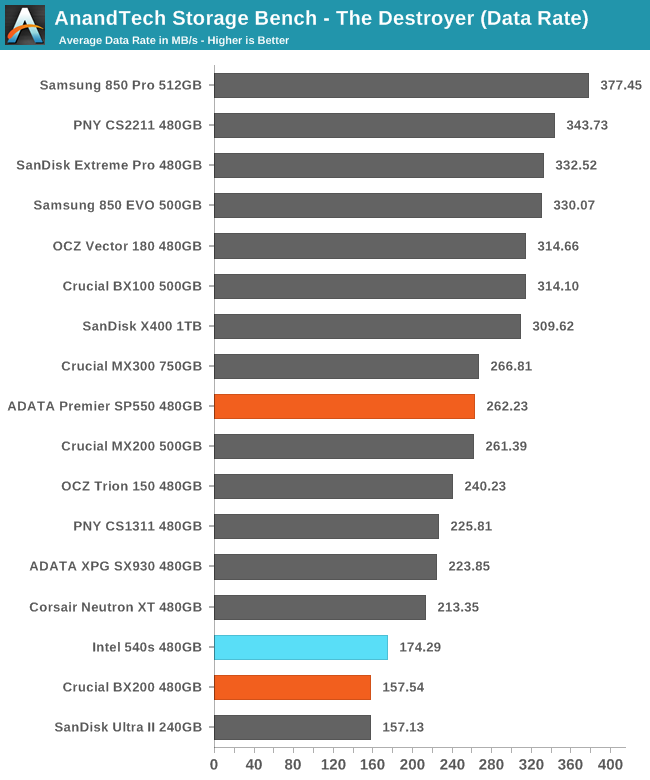
On The Destroyer, the ADATA SP550 was able to punch above its weight and perform on par with planar TLC drives of twice the capacity, while the Crucial BX200 performed below expectations. The Intel 540s unfortunately demonstrates more of the latter, with an average data rate that is not as bad as the BX200 but is still clearly outclassed by the Phison S10 TLC drives and the SP550.
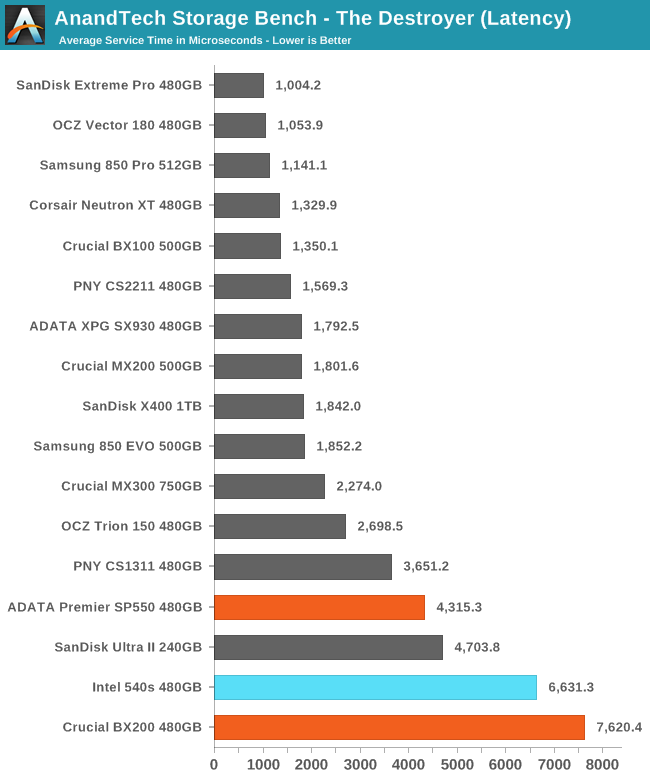
As with the average data rate, the average service time of the 540s is poor but not quite as bad as the BX200. The SP550 didn't rank much higher on this metric, but in absolute terms it was significantly faster.
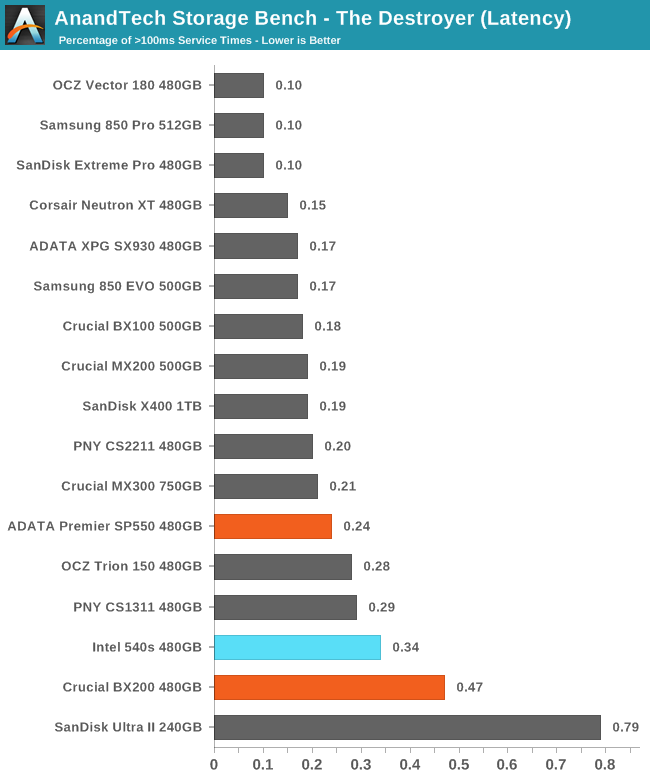
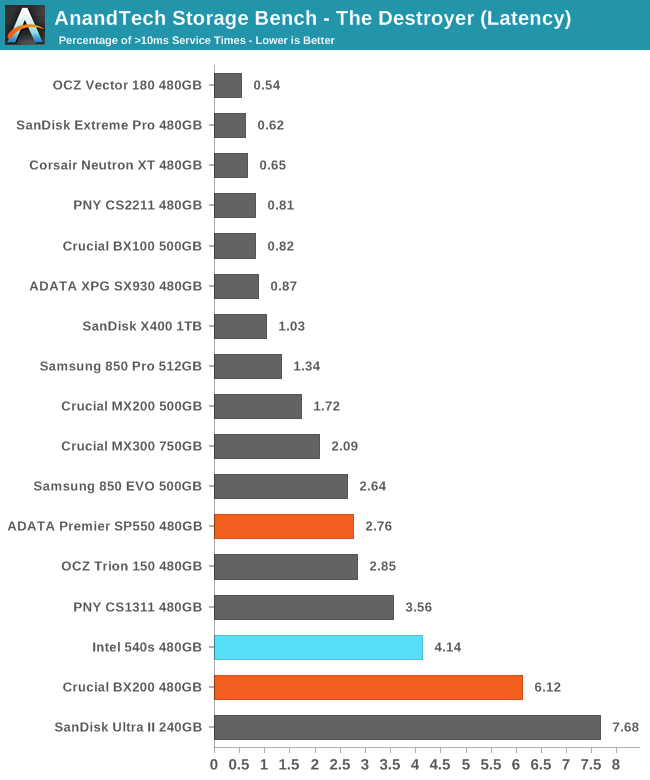
The frequency of latency outliers shows similar rankings, with the Intel 540s near the bottom of the chart and between the two SM2256 drives.
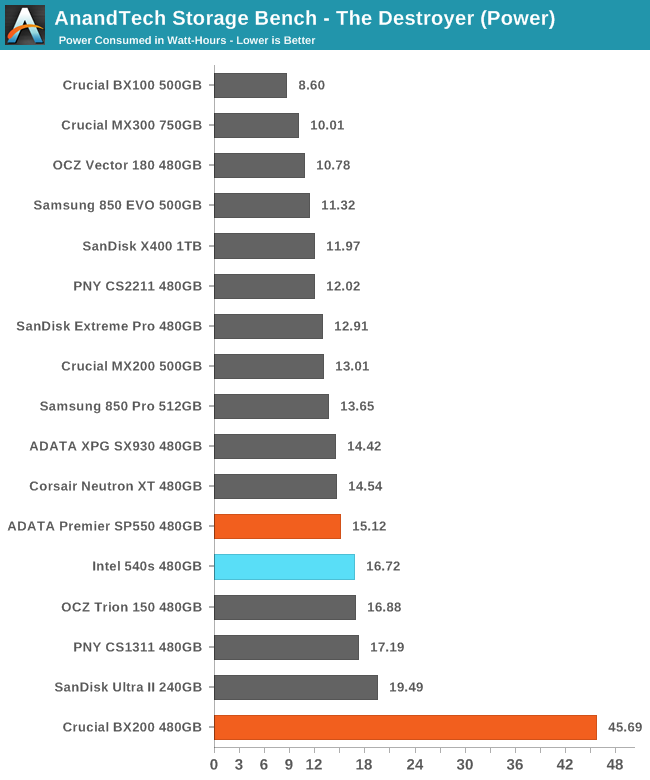
Power efficiency has regressed slightly compared to the SP550, but the Intel 540s clearly doesn't have anything horribly wrong going on the way the BX200 did.
AnandTech Storage Bench - Heavy
Our Heavy storage benchmark is proportionally more write-heavy than The Destroyer, but much shorter overall. The total writes in the Heavy test aren't enough to fill the drive, so performance never drops down to steady state. This test is far more representative of a power user's day to day usage, and is heavily influenced by the drive's peak performance. The Heavy workload test details can be found here.
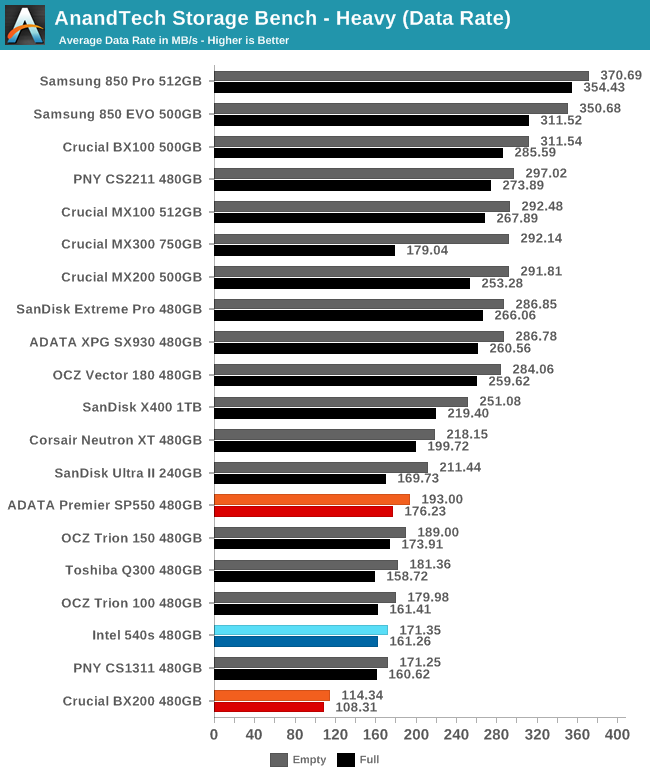
On the Heavy test, the Intel 540s achieves an average data rate that is once again between the two SM2256 drives, but this is also par for Phison TLC drives.
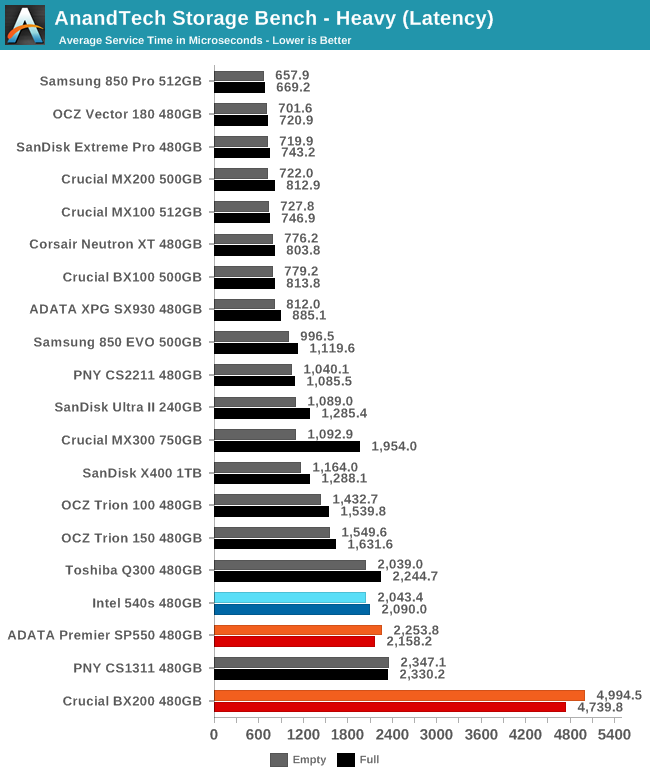
The average service time of the Intel 540s is actually slightly better than the SP550 and significantly better than the BX200, but still poor compared to the best planar TLC drives.
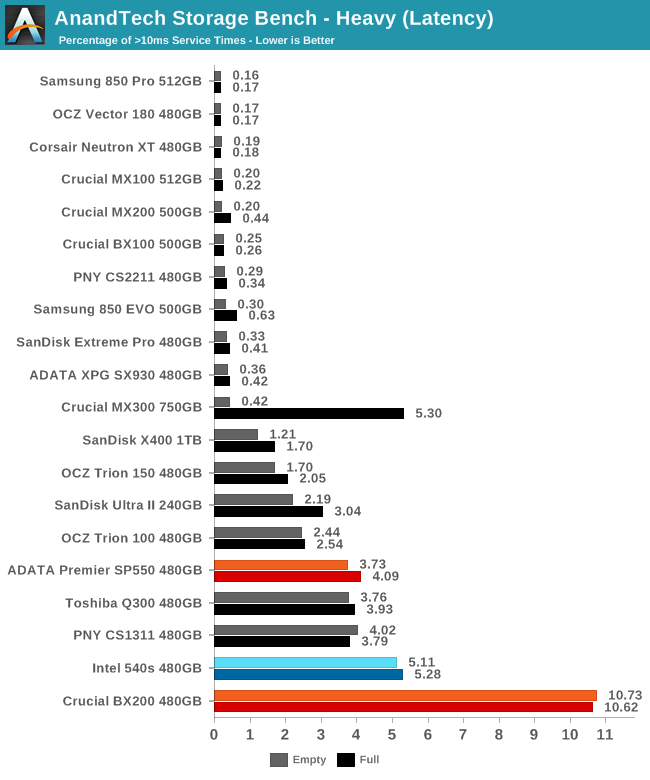
The frequency of high-latency outliers for the 540s is half that of the BX200, but still clearly worse than the other TLC drives and more than an order of magnitude higher than the MLC drives.
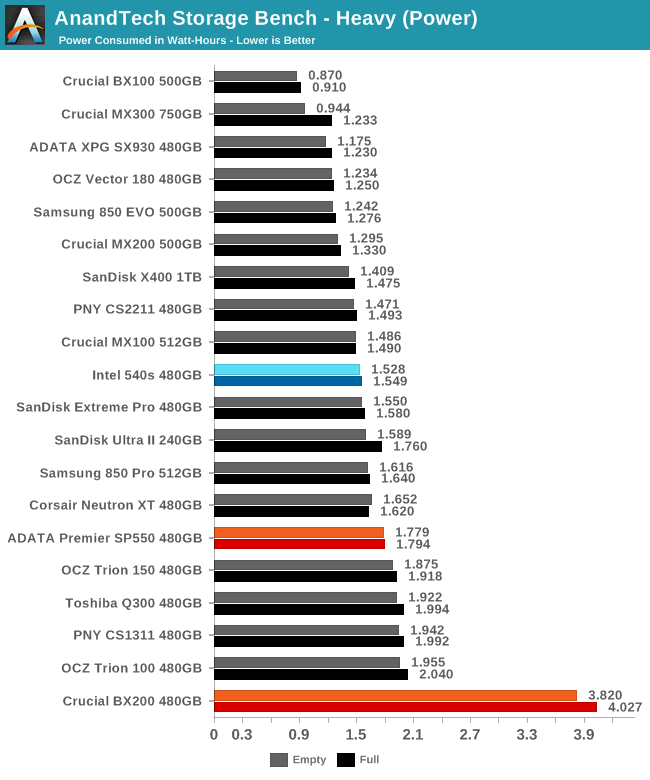
The Intel 540s managed to improve on power efficiency compared to either SM2256 drive, putting it around the middle of the rankings.
AnandTech Storage Bench - Light
Our Light storage test has relatively more sequential accesses and lower queue depths than The Destroyer or the Heavy test, and it's by far the shortest test overall. It's based largely on applications that aren't highly dependent on storage performance, so this is a test more of application launch times and file load times. This test can be seen as the sum of all the little delays in daily usage, but with the idle times trimmed to 25ms it takes less than half an hour to run. Details of the Light test can be found here.
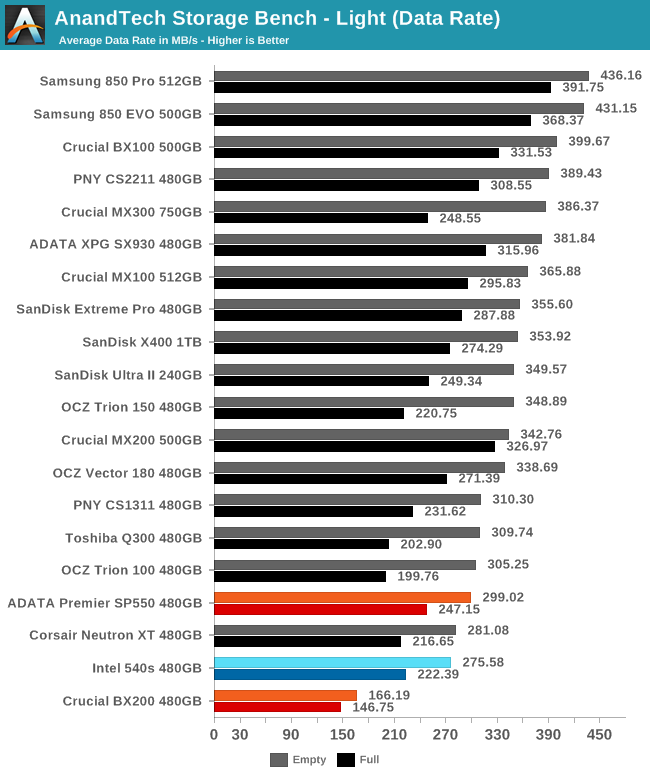
Both of the SM2256 drives were near the bottom of the ranking for average data rate on the Light test, and the Intel 540s doesn't improve any. The SP550 had previously performed relatively well for a TLC drive when full, but the latest Phison S10 TLC drives have mostly caught up.
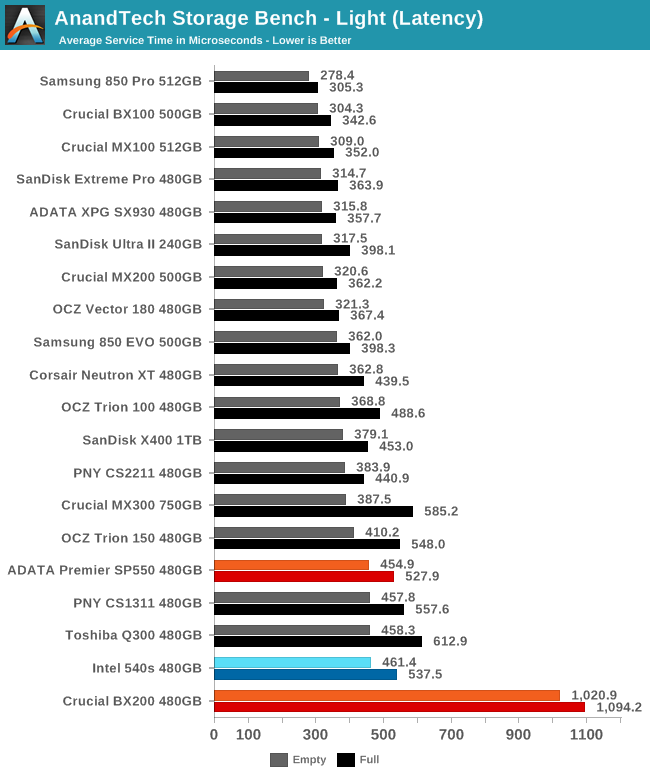
The average service time of the Intel 540s is about the same as the SP550 and close to that of most Phison S10 TLC drives, but the Marvell-based TLC drives from SanDisk do significantly better.
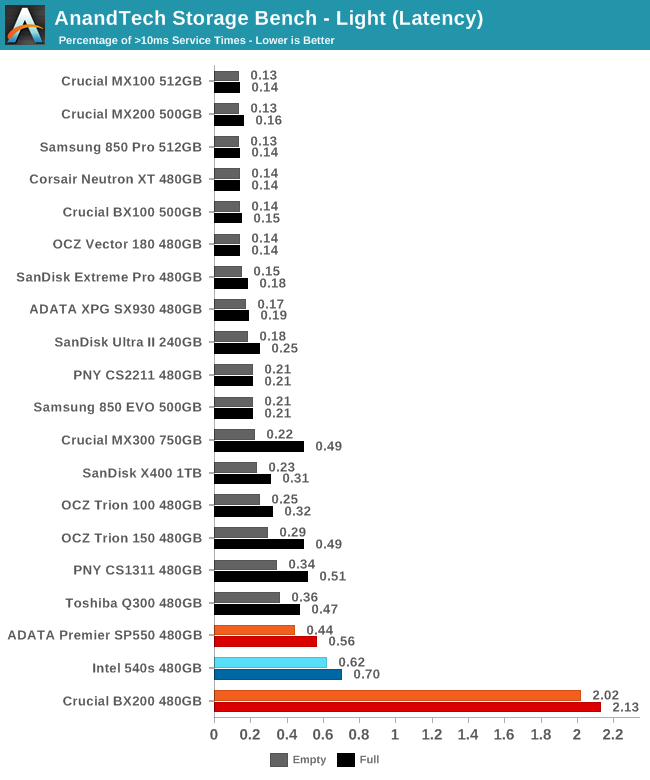
The frequency of latency outliers for the Intel 540s is a little bit worse than the SP550, but all three Silicon Motion-based drives are at the bottom of the chart.
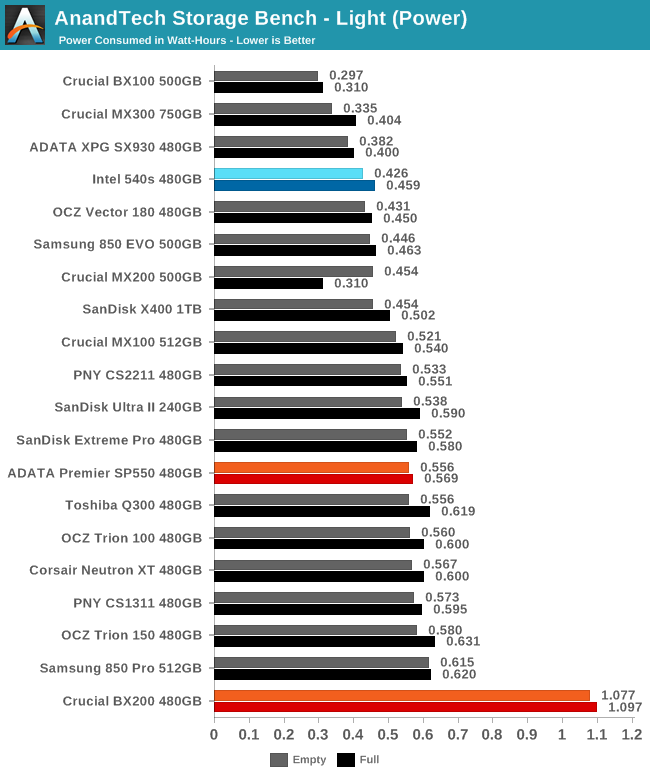
The power efficiency of the Intel 540s is quite good overall and well ahead of any other planar TLC drive.
Random Read Performance
The random read test requests 4kB blocks and tests queue depths ranging from 1 to 32. The queue depth is doubled every three minutes, for a total test duration of 18 minutes. The test spans the entire drive, which is filled before the test starts. The primary score we report is an average of performances at queue depths 1, 2 and 4, as client usage typically consists mostly of low queue depth operations.
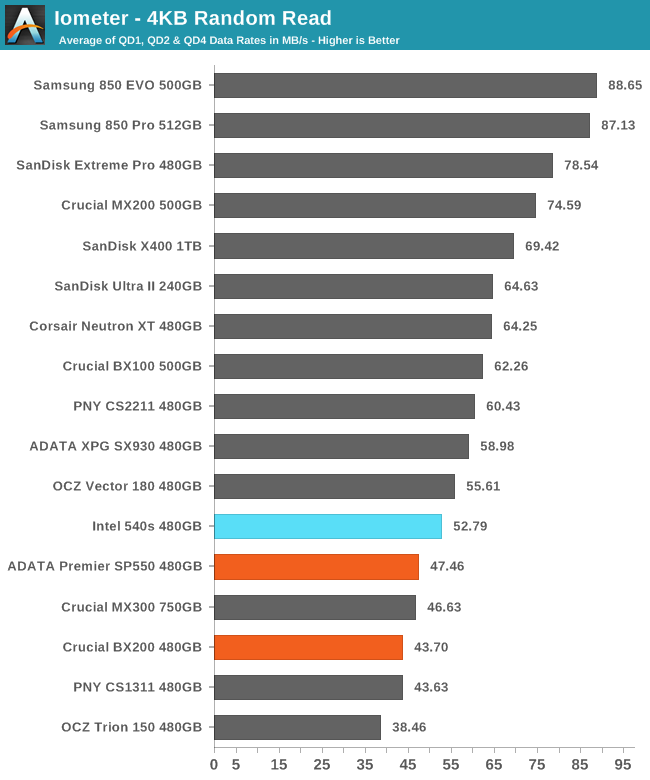
The random read speed of the Intel 540s is a significant improvement over both SM2256 drives and Phison S10 TLC drives, but isn't quite as fast as the MLC drives or SanDisk and Samsung TLC.
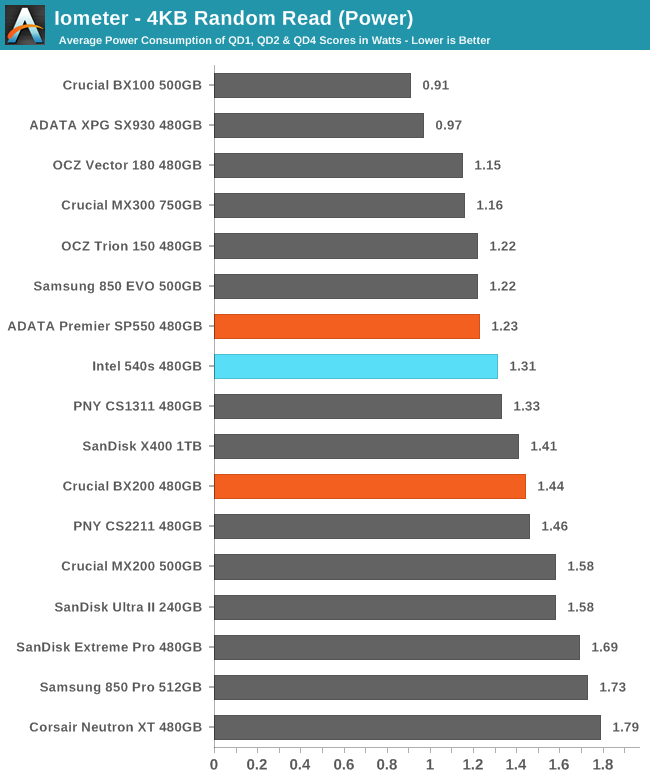
Power usage of the Intel 540s was slightly higher than the SP550, but given the performance increase their efficiency is similar and good overall.
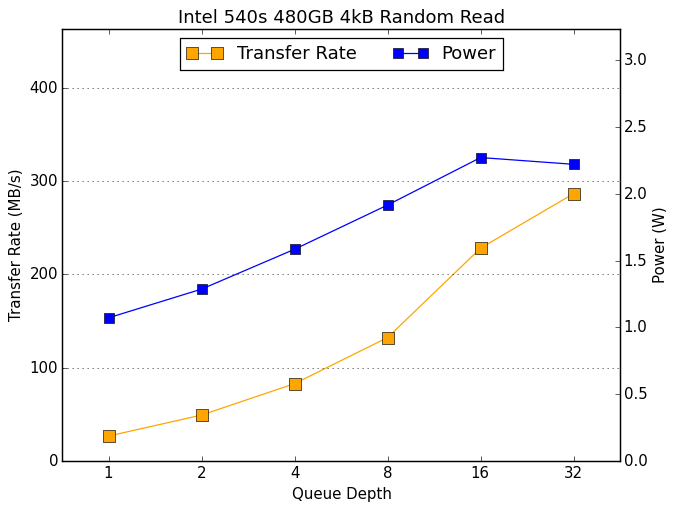 |
|||||||||
The Intel 540s drew more power and delivered more performance than the SP550 at every queue depth until QD32, where the SP550 performed slightly better.
Random Write Performance
The random write test writes 4kB blocks and tests queue depths ranging from 1 to 32. The queue depth is doubled every three minutes, for a total test duration of 18 minutes. The test is limited to a 16GB portion of the drive, and the drive is empty save for the 16GB test file. The primary score we report is an average of performances at queue depths 1, 2 and 4, as client usage typically consists mostly of low queue depth operations.
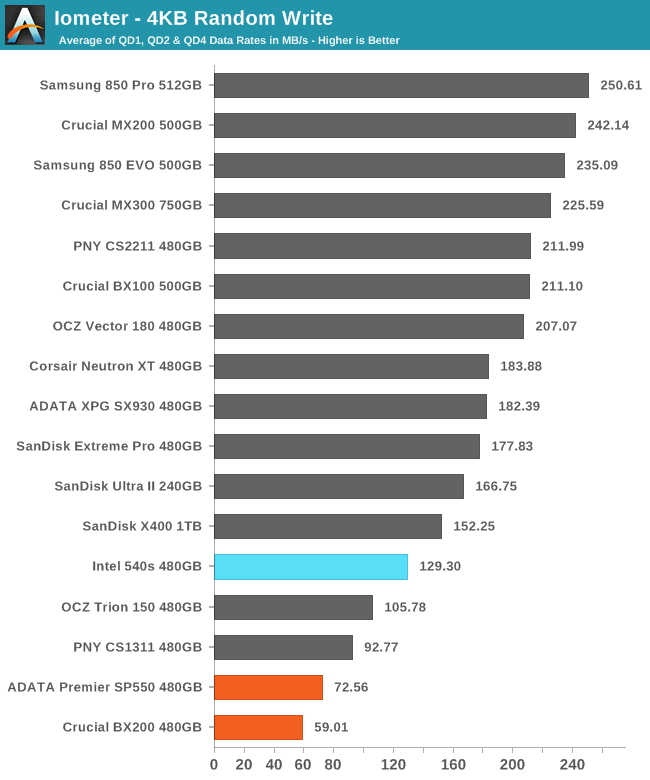
The Intel 540s shows almost double the performance on the random write test that the SM2256 drives did. This puts it well ahead of the Phison-based TLC drives and close to SanDisk's TLC drives.
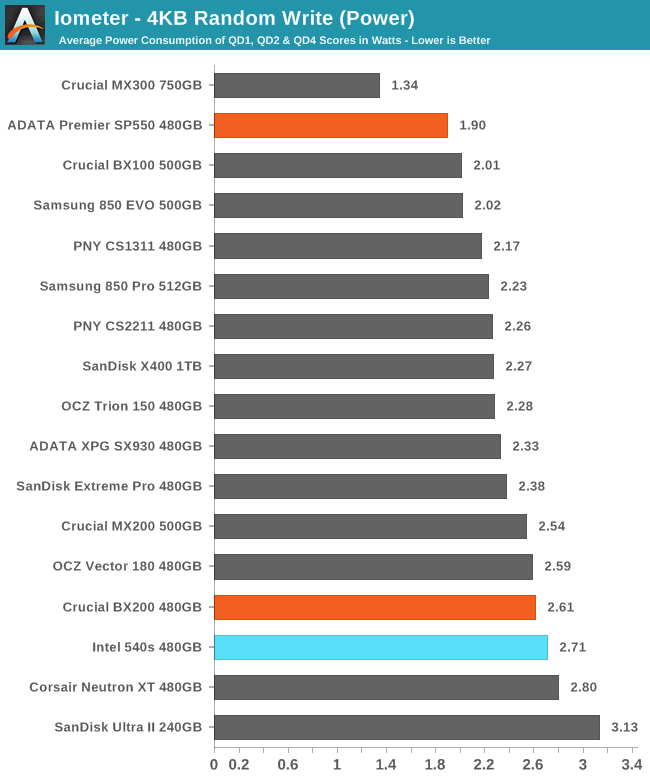
The Intel 540s had relatively high power draw during the random test, but it certainly wasn't the least efficient drive.
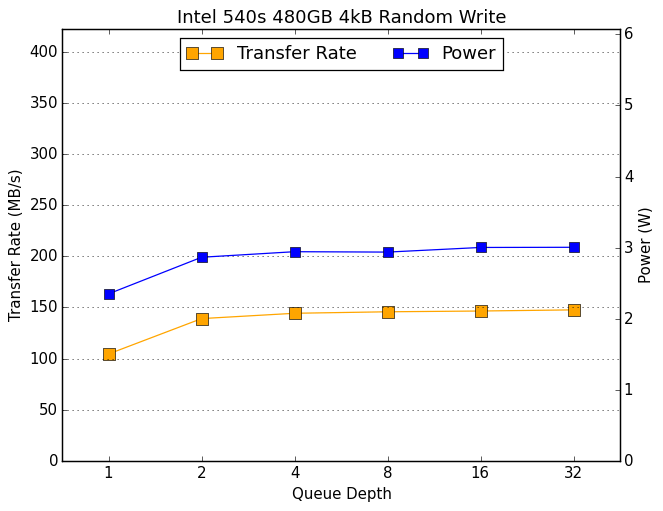 |
|||||||||
The random write performance of the Intel 540s increases moderately from QD1 to QD2 and only very slightly after that. The SM2256 drives started out slower and stayed there, though the BX200 drew more power with higher queue depths. Most budget TLC drives show relatively little scaling with queue depth here, with a few exceptions like the OCZ Trion 150 jumping up from QD4 and QD8.
Sequential Read Performance
The sequential read test requests 128kB blocks and tests queue depths ranging from 1 to 32. The queue depth is doubled every three minutes, for a total test duration of 18 minutes. The test spans the entire drive, and the drive is filled before the test begins. The primary score we report is an average of performances at queue depths 1, 2 and 4, as client usage typically consists mostly of low queue depth operations.
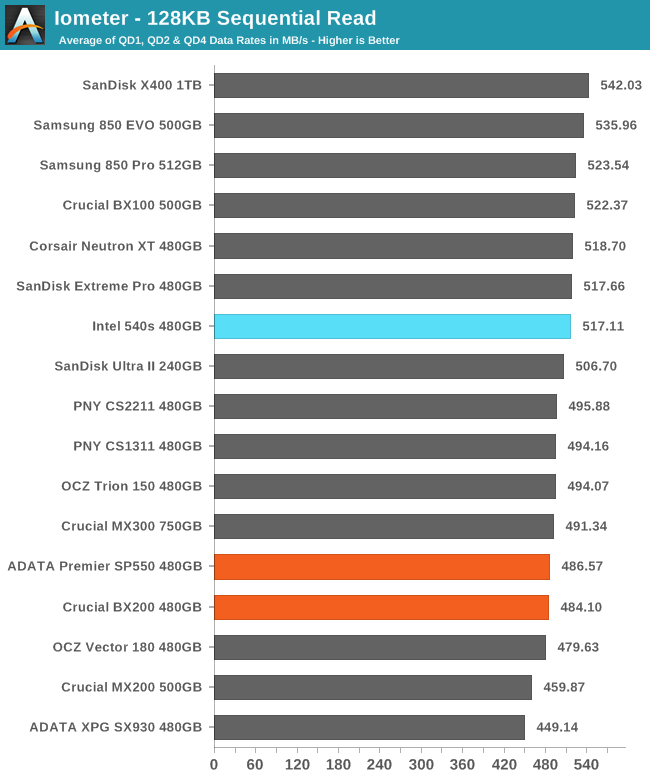
Sequential read performance of SATA drives continues to be pretty boring. The Intel 540s scores better than any other planar TLC drive, but the spread of scores is still quite small.
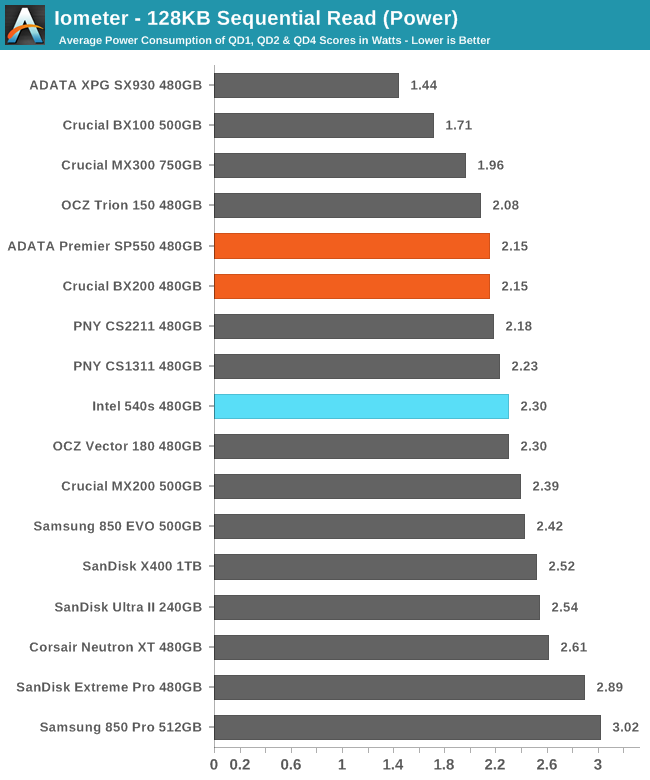
Power consumption shows much more variability than performance for sequential reads, and the 540s is a little less efficient than the SM2256 drives here.
 |
|||||||||
For most drives, their ranking is determined by their QD1 performance as at higher queue depths almost all drives are saturating the SATA link. The Intel 540s has very good QD1 performance, but doesn't make it all the way to peak performance until the queue is at the full depth of 32.
Sequential Write Performance
The sequential write test writes 128kB blocks and tests queue depths ranging from 1 to 32. The queue depth is doubled every three minutes, for a total test duration of 18 minutes. The test spans the entire drive, and the drive is filled before the test begins. The primary score we report is an average of performances at queue depths 1, 2 and 4, as client usage typically consists mostly of low queue depth operations.
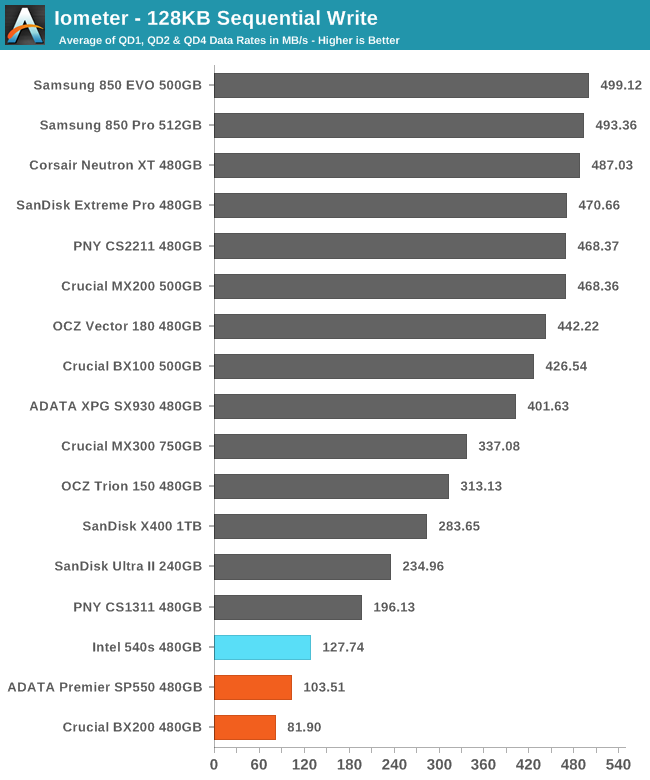
The Intel 540s manages to significantly improve on the greatest weakness of the SM2256 drives, but the sequential write speed it delivers is still much worse than any of the other competition.
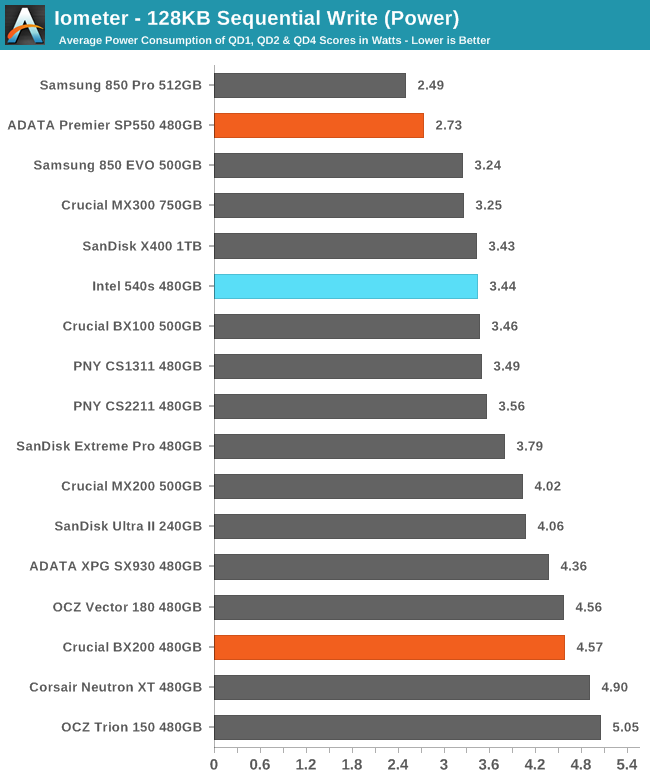
The power usage of the Intel 540s is higher than the SP550 by enough that efficiency actually regressed a tiny bit, but they're both quite inefficient given how much slower they are than the competition.
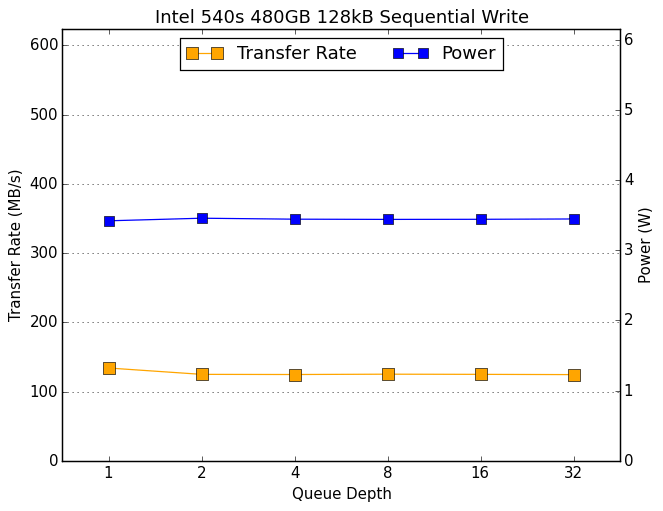 |
|||||||||
The Intel 540s shows essentially no dependence between sequential write speed and queue depth, which is not uncommon.
Mixed Random Read/Write Performance
The mixed random I/O benchmark starts with a pure read test and gradually increases the proportion of writes, finishing with pure writes. The queue depth is 3 for the entire test and each subtest lasts for 3 minutes, for a total test duration of 18 minutes. As with the pure random write test, this test is restricted to a 16GB span of the drive, which is empty save for the 16GB test file.
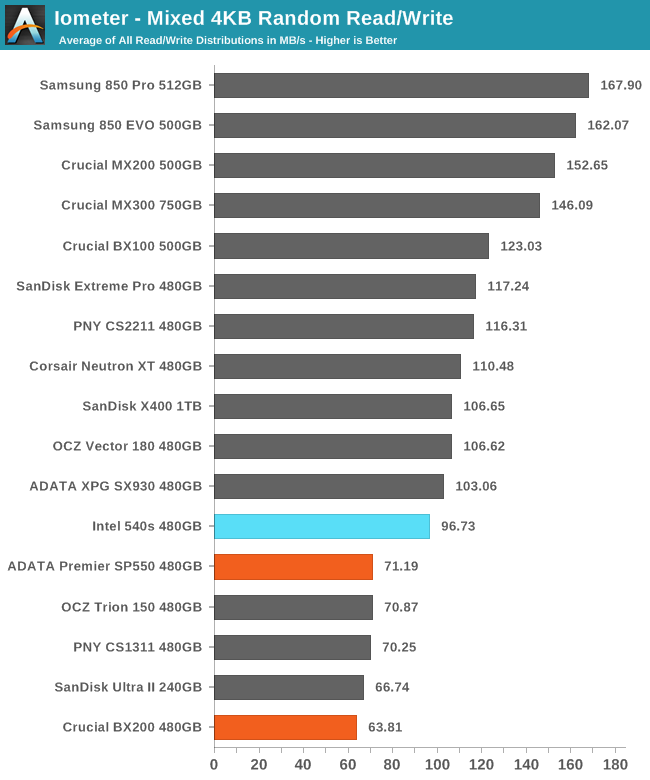
On the mixed random I/O test the Intel 540s has a stark advantage over almost all other planar TLC drives, and is close to the low-end MLC drives and SanDisk X400.
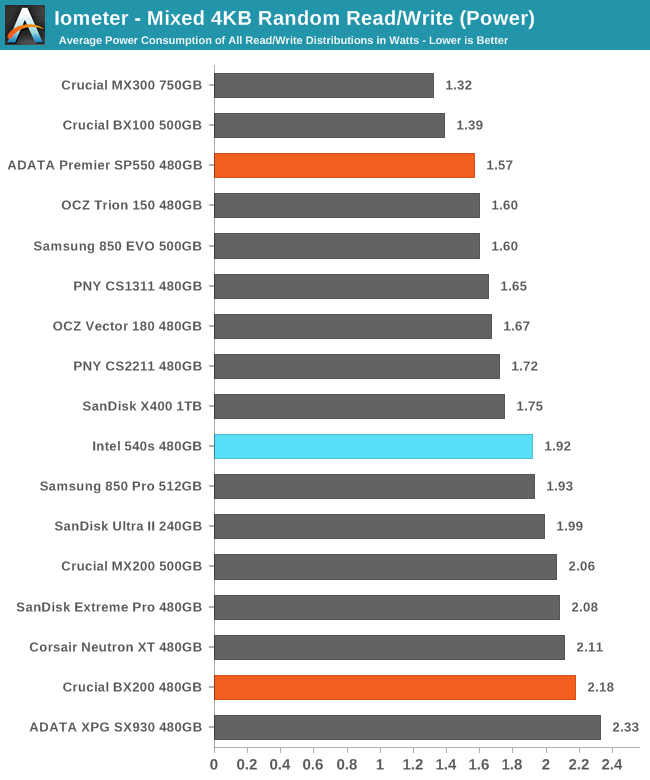
Power consumption is middle of the road, so the Intel 540s comes out at ahead of most of the TLC drives in terms of efficiency, though the SP550 is not far behind.
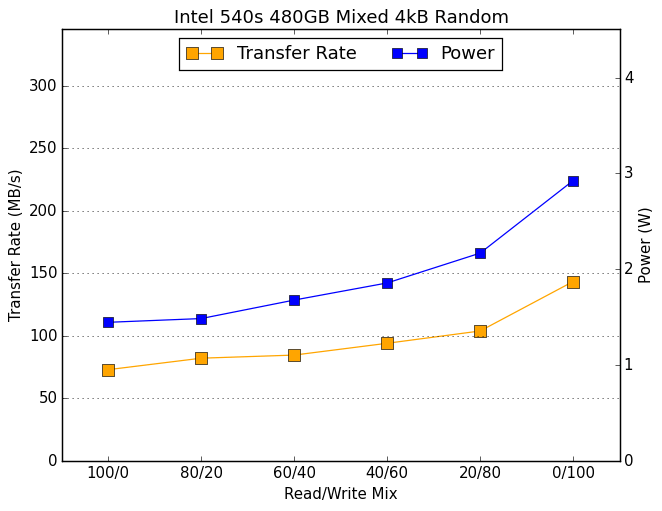 |
|||||||||
The performance of the Intel 540s never dropped as the proportion of writes in the workload increased, but it also didn't show the common big jump in performance during the final pure-write phase of the test.
Mixed Sequential Read/Write Performance
The mixed sequential access test covers the entire span of the drive and uses a queue depth of one. It starts with a pure read test and gradually increases the proportion of writes, finishing with pure writes. Each subtest lasts for 3 minutes, for a total test duration of 18 minutes. The drive is filled before the test starts.
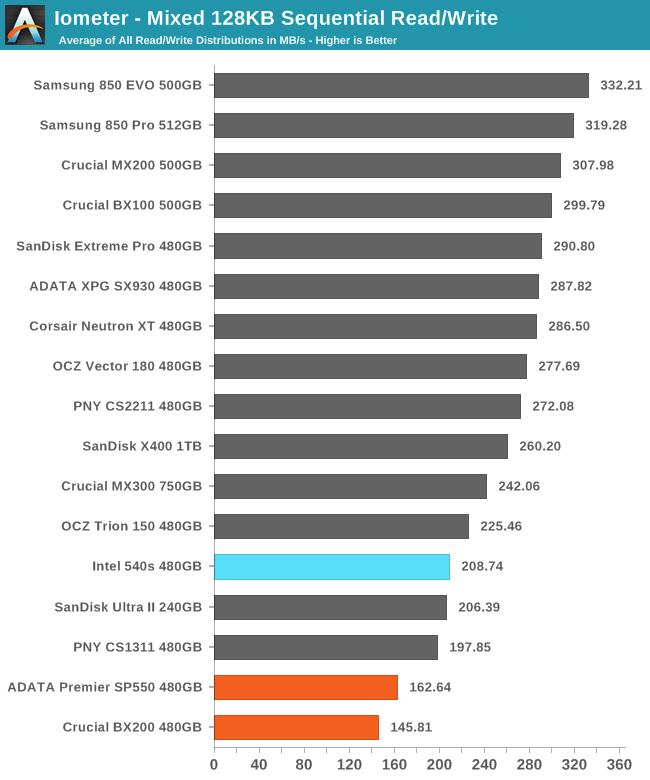
The mixed sequential I/O performance of the Intel 540s is significantly improved over the SM2256 drives, but that still only brings it up to par for planar TLC.
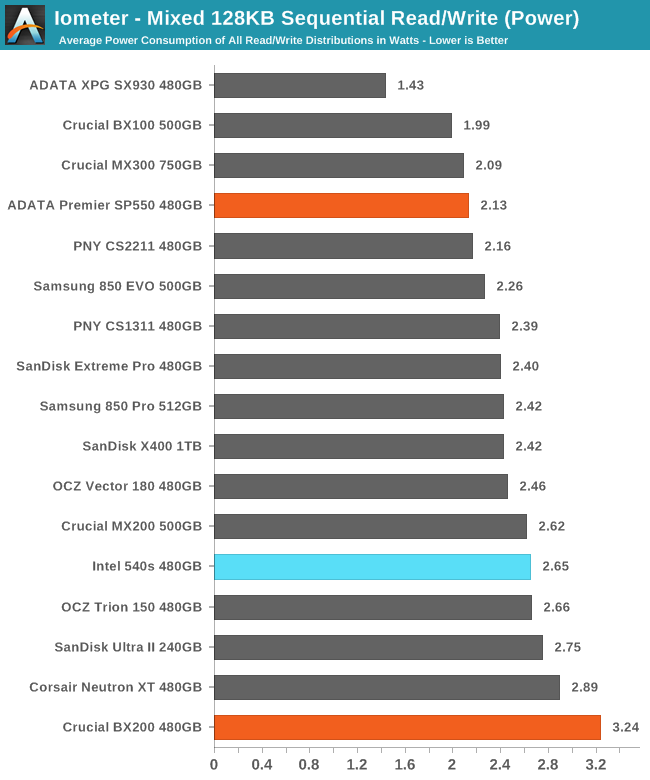
The power usage of the Intel 540s is relatively high, so it doesn't have great efficiency even by TLC standards.
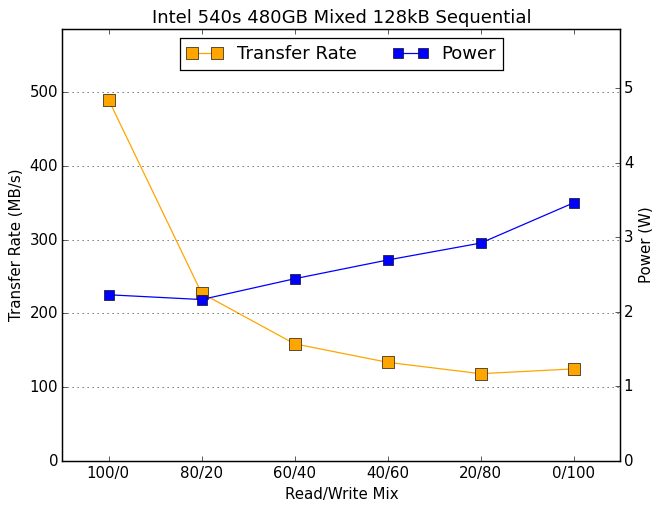 |
|||||||||
The Intel 540s is both faster and more power hungry than the SP550 at every point during this test. Performance still doesn't bounce back appreciably with the pure writes phase of the test, which keeps the average down despite the good read performance at the beginning.
ATTO
ATTO's Disk Benchmark is a quick and easy freeware tool to measure drive performance across various transfer sizes.
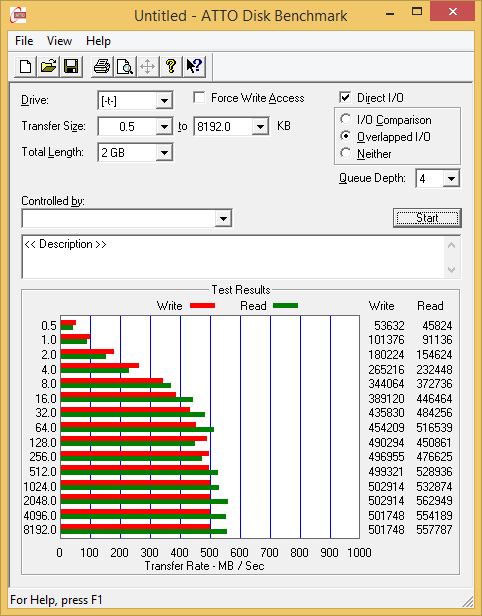 |
|||||||||
The Intel 540s's performance is a bit uneven during the ATTO benchmark, but its write speed advantage over the SP550 is still quite clear.
AS-SSD
AS-SSD is another quick and free benchmark tool. It uses incompressible data for all of its tests, making it an easy way to keep an eye on which drives are relying on transparent data compression. The short duration of the test makes it a decent indicator of peak drive performance.
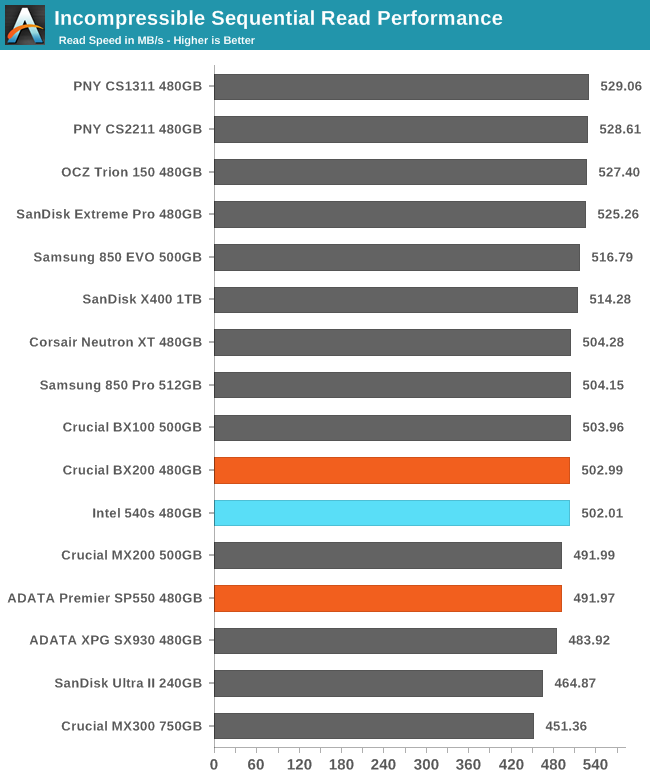
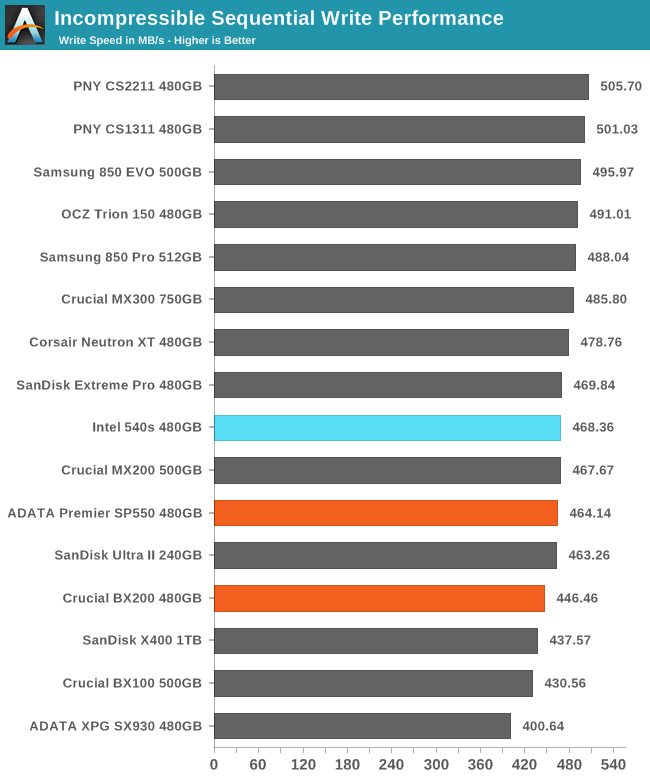
The AS-SSD test does very little to differentiate between drives, but it at least shows that the Intel 540s can reach similar peak speeds to its competition.
Idle Power Consumption
Since the ATSB tests based on real-world usage cut idle times short to 25ms, their power consumption scores paint an inaccurate picture of the relative suitability of drives for mobile use. During real-world client use, a solid state drive will spend far more time idle than actively processing commands. Our testbed doesn't support the deepest DevSlp power saving mode that SATA drives can implement, but we can measure the power usage in the intermediate slumber state where both the host and device ends of the SATA link enter a low-power state and the drive is free to engage its internal power savings measures.
We also report the drive's idle power consumption while the SATA link is active and not in any power saving state. Drives are required to be able to wake from the slumber state in under 10 milliseconds, but that still leaves plenty of room for them to add latency to a burst of I/O. Because of this, many desktops default to either not using SATA Aggressive Link Power Management (ALPM) at all or to only enable it partially without making use of the device-initiated power management (DIPM) capability. Additionally, SATA Hot-Swap is incompatible with the use of DIPM, so our SSD testbed usually has DIPM turned off during performance testing.
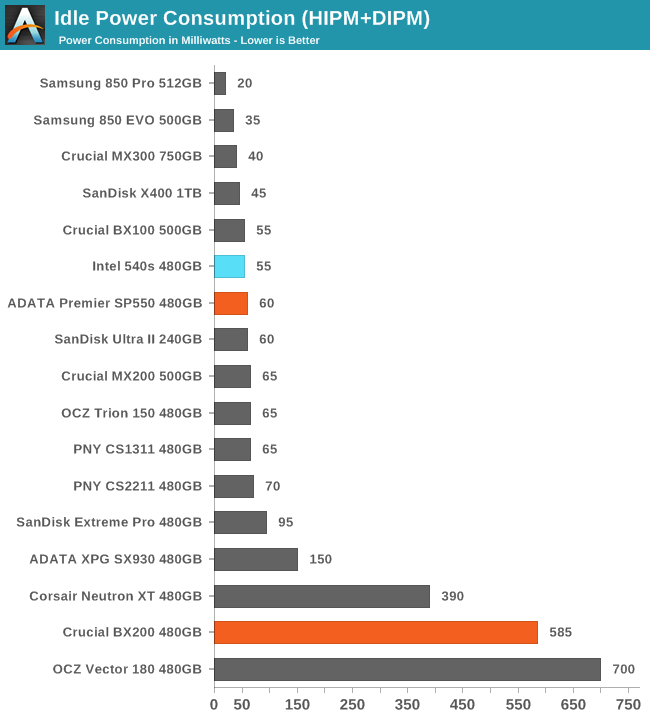
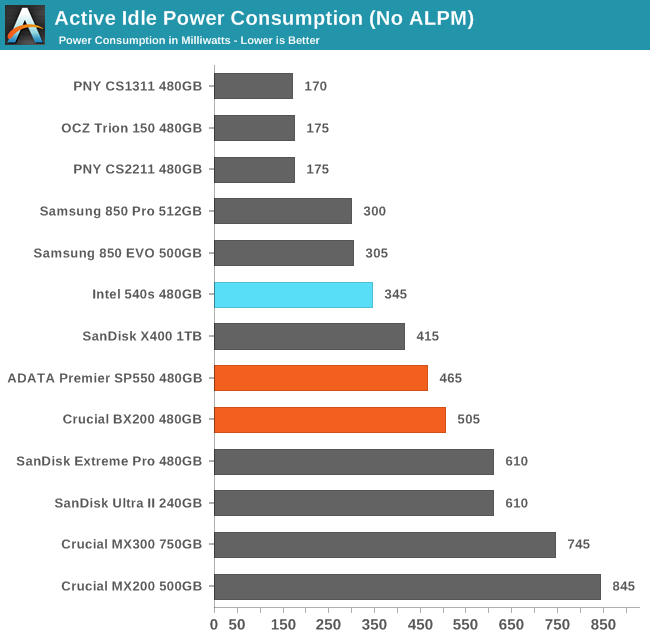
The slumber power state is working correctly on the Intel 540s and allows for very slightly lower idle power draw than the SP550. Active idle power is significantly improved over the SM2256 and is now behind only Samsung and Phison controllers. Silicon Motion's 40nm SM2258 clearly beats Marvell's 28nm 88SS1074 used in the SanDisk X400 and Crucial MX300.
Final Words
The Intel SSD 540s is their first entry level consumer SSD in quite a while, and our first look at Silicon Motion's new SM2258 controller. It's a little surprising to see Intel being an early adopter of a third-party SSD controller after their SandForce-based drives spent so much time going through Intel's QA, but the SM2258 is not a radical departure from Silicon Motion's earlier controllers, which have a pretty good track record for reliability.
Intel's use of the same 16nm SK Hynix TLC NAND as in the ADATA Premier SP550 allowed us to make a direct comparison of the SM2258 controller against the preceding SM2256, and the Crucial BX200 provides another point of comparison with Micron's 16nm TLC instead. The 540s is much better than the BX200 in every way, but that's not saying much. Against the SP550, the Intel 540s was not able to score a clear win. On most synthetic benchmarks the 540s improved performance over the SM2256 drives, mitigating their most glaring weaknesses and occasionally rising above the field of budget TLC drives in general. These improvements did not translate into a significant advantage over the SP550 on our real-world AnandTech Storage Bench tests. The ADATA SP550 is still faster overall for realistic workloads with bursts of I/O, even though it is slower under the sustained load of synthetic benchmarks.
The wide disparity in performance between the Crucial BX200 and ADATA SP550 showed just how much firmware tuning can affect drive performance. I think it's likely that later this year we'll see a more refined SM2258 drive, perhaps even on planar TLC before 3D NAND is cheap enough.
| Budget SSD Retail Price Comparison | ||||
| Capacity | 120-128GB | 240-256GB | 480-512GB | 960-1024GB |
| Intel SSD 540s 2.5" | $51.95 (43¢/GB) | $93.91 (39¢/GB) | $149.99 (31¢/GB) | $304.96 (30¢/GB) |
| Intel SSD 540s M.2 | $49.95 (42¢/GB) | $91.77 (38¢/GB) | $155.65 (32¢/GB) | $305.29 (31¢/GB) |
| ADATA SP550 | $37.88 (32¢/GB) | $57.99 (24¢/GB) | $107.99 (22¢/GB) | $205.99 (21¢/GB) |
| OCZ TR150 | $37.99 (32¢/GB) | $59.99 (25¢/GB) | $99.95 (21¢/GB) | $199.99 (21¢/GB) |
| SanDisk X400 | $49.59 (39¢/GB) | $80.19 (31¢/GB) | $126.23 (25¢/GB) | $237.99 (23¢/GB) |
Against the wider field of competitors, the Intel 540s is clearly an entry-level SSD, intended for light workloads. It cannot keep pace with SanDisk's X400 or even the current generation of Phison S10-based drives like the Toshiba OCZ TR150 (formerly Trion 150). The ADATA SP550 has held on to a place in the market by usually being one of the cheapest drives available, but at the moment it is mostly tied with the TR150 on price, making the latter a better purchase given its better performance.
The current retail pricing of the Intel SSD 540s makes my recommendation quite simple: don't buy. The 180GB and 360GB models are only a few dollars cheaper than the next size up, and the four standard sized models are priced above many MLC drives. The OCZ TR150 provides better performance for a far lower price. The SanDisk X400 provides much better performance, the same 5-year warranty period of the 540s, and M.2 models for a significantly lower price. ADATA has also recently announced M.2 versions of the SP550, which will probably be only a little more expensive than the 2.5" drives, providing a very welcome cheap M.2 option.

